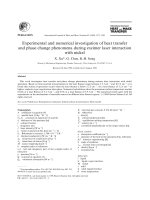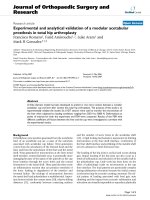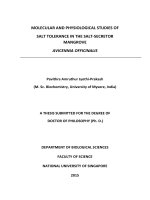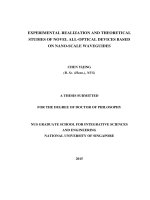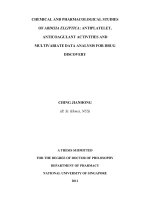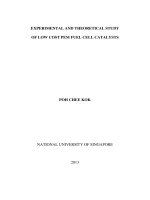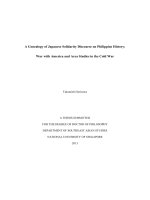Experimental and analytical studies of the behavior of cold formed steel roof truss elements (tt)
Bạn đang xem bản rút gọn của tài liệu. Xem và tải ngay bản đầy đủ của tài liệu tại đây (3.33 MB, 94 trang )
EXPERIMENTAL AND ANALYTICAL STUDIES OF
THE BEHAVIOR OF COLD-FORMED STEEL
ROOF TRUSS ELEMENTS
Nuthaporn Nuttayasakul
Dissertation submitted to the Faculty of the
Virginia Polytechnic Institute and State University
in partial fulfillment for the requirements for the degree of
DOCTOR OF PHILOSOPHY
In
Civil Engineering
W. Samuel Easterling, Chairman
Thomas M. Murray
Finley A. Charney
Carin L. Roberts-Wollmann
Mehdi Setareh
November 3, 2005
Blacksburg, Virginia
Keywords: cold-formed steel, elemental test, full scale test, stub column test,
flexural test, distortional buckling, local buckling
Copyright 2005, Nuthaporn Nuttayasakul
EXPERIMENTAL AND ANALYTICAL STUDIES OF
THE BEHAVIOR OF COLD-FORMED STEEL
ROOF TRUSS ELEMENTS
Nuthaporn Nuttayasakul
ABSTRACT
Cold-formed steel roof truss systems that use complex stiffener patterns in
existing hat shape members for both top and bottom chord elements are a growing
trend in the North American steel framing industry. When designing cold-formed
steel sections, a structural engineer typically tries to improve the local buckling
behavior of the cold-formed steel elements. The complex hat shape has proved to
limit the negative influence of local buckling, however, distortional buckling can
be the controlling mode of failure in the design of chord members with
intermediate unbraced lengths. The chord member may be subjected to both
bending and compression because of the continuity of the top and bottom chords.
These members are not typically braced between panel points in a truss.
Current 2001 North American Specifications (NAS 2001) do not provide an
explicit check for distortional buckling. This dissertation focuses on the behavior
of complex hat shape members commonly used for both the top and bottom chord
elements of a cold-formed steel truss. The results of flexural tests of complex hat
shape members are described. In addition, stub column tests of nested C-sections
used as web members and full scale cold-formed steel roof truss tests are reported.
Numerical analyses using finite strip and finite element procedures were
developed for the complex hat shape chord member in bending to compare with
experimental results.
Both elastic buckling and inelastic postbuckling finite
element analyses were performed. A parametric study was also conducted to
investigate the factors that affect the ultimate strength behavior of a particular
complex hat shape.
The experimental results and numerical analyses confirmed that modifications to
the 2001 North American Specification are necessary to better predict the flexural
strength of complex hat shape members, especially those members subjected to
distortional buckling. Either finite strip or finite element analysis can be used to
better predict the flexural strength of complex hat shape members. Better
understanding of the flexural behavior of these complex hat shapes is necessary to
obtain efficient, safe design of a truss system. The results of these analyses will
be presented in the dissertation.
iii
ACKNOWLEDGEMENTS
I would like to express my gratitude to Dr. W. Samuel Easterling for his guidance
and patience. I would also like to thank you Dr. Thomas M. Murray, Dr. Carin
Roberts-Wollmann, Dr. Finley Charney, and Dr. Mehdi Setareh for serving on the
committee.
I would also like to thank Brett Farmer and Dennis Huffman for their contribution
to the fabrication and testing of the experimental part of this dissertation.
I would also like to extend my gratitude to Consolidated System Inc., which
sponsored the experimental portion of this research. I would like to thank Mr.
Harry Collins and Mr. Eric Jacobsen for their contribution and help with this
study.
iv
TABLE OF CONTENTS
page
ABSTRACT ………………………………………………..…….
ii
ACKNOWLEDGEMENT …………………………………..…….
iv
TABLE OF CONTENTS ………………………………………….
v
LIST OF TABLES ………………………………………………..
ix
LIST OF FIGURES ……………………………………………….
x
CHAPTER 1 INTRODUCTION ………………………………….
1
1.1 Background …………………………..……….…
1
1.2 Statement of Problem ………….…………………
2
1.3 Objective & Scope …………….…………………
4
1.4 Organization of this Dissertation …………………..
5
CHAPTER 2 LITERATURE REVIEW ……………………………
6
2.1 Introduction …………………….………..…….….
6
2.2 Cold-formed Steel Column ……….……………….
6
2.3 Cold-formed Steel Flexural Member ….……………
9
2.4 Finite Strip Method …………………….………...
11
2.5 Direct Strength Method …………….……………...
12
2.5.1 Column Strength ………….……………...
12
2.5.1.1 Flexural, Torsional, or Flexural-Torsional
Buckling .………………….……...
13
2.5.1.2 Local Buckling .…………….……...
13
2.5.1.3 Distortional Buckling .……….……...
13
v
2.5.2 Flexural Strength ………….…………..…...
14
2.5.2.1 Lateral-Torsional Buckling ….…..…...
14
2.5.2.2 Local Buckling .…………….….…...
15
2.5.2.3 Distortional Buckling .……….….…...
15
2.6 Truss Design …………….…………....…………...
16
2.7 Computational Modeling …………….……………...
17
2.8 Application of Prior Research to the Current Project …...
19
CHAPTER 3 STUB COLUMNS TESTS FOR WEB MEMBERS …......
21
3.1 Introduction …………………….………..…….….
21
3.2 Test Specimens …………………….……..……..…
21
3.3 Material Properties …………………….…..…….....
23
3.4 Test Set-Up ………………...……….…..……..….
23
3.5 Results ………………………………….…..…..…
24
3.6 Comparison of Test Strengths with Design Strengths …..
26
3.7 Conclusions …………………………………..…...
27
CHAPTER 4 LATERALLY UNBRACED FLEXURAL TESTS OF
CHORD MEMBERS ……………………………...….
28
4.1 Introduction ……………………………….…..…..
28
4.2 Background ………………………………………..
28
4.3 Experimental Study ……………………..….………. 29
4.4 Results ………………………………..….…….….
31
4.5 Discussion of Results …………………..…….……..
33
4.6 Conclusions ……………………………..….……...
41
vi
CHAPTER 5 FULL SCALE TESTING OF COLD-FORMED STEEL
TRUSSES WITH COMPLEX HAT SHAPE CHORD
MEMBER ……………………………………..…….
42
5.1 Introduction ……………………………...………..
42
5.2 Experimental Study ………………………..……….
42
5.3 Results ……………………………………………. 45
5.3.1 T1A Results ………….….……….……...
45
5.3.2 T1C Results …………..….…….………...
49
….…..…..….…….………... 51
5.3.3 T1 Results
5.4 Discussion of Results …….………………..……….. 52
5.5 Conclusion & Recommendations …………..……….. 56
CHAPTER 6 FINITE ELEMENT STUDY OF COMPLEX HAT SHAPES
USED AS TRUSS CHORD MEMBERS ……………. 57
6.1 Introduction ……………………………….……..
57
6.2 Validation of Finite Element Model …………...……
57
6.3 Finite Element Study Results …………...………….
60
6.4 Parametric Study
………………………….……. 65
6.5 Conclusions …………………………….………..
69
CHAPTER 7 SUMMARYS, CONCLUSIONS AND
RECOMMENDATIONS …………………………….
71
………………………….…………..
71
7.5 Conclusions ………………………….…………..
72
7.2 Recommendations …………………..…….….….
73
7.1 Summary
References ………………………………………………….….….
vii
75
Appendix A …………………..…………………………….….….
78
RELIABILITY ANALYSIS EXAMPLE CALCULATIONS ……
78
Appendix B …………………..……….…………………….….….
80
ABAQUS INPUT EXAMPLE ………………………….….….
80
viii
LIST OF TABLES
Table 3.1
The Geometric Properties of the Tested Sections ……….. 22
Table 3.2
The Summary of the Tested Specimens Length
Table 3.3
The Coupon Test Results from the Tested Specimens …...
23
Table 3.4
The Summary of the Test Results ……………………..
24
Table 3.5
Test to Predicted Ratio
Table 4.1
Measured Geometric Properties of Tested Sections
Table 4.2
Tensile Properties …………………………….……. 31
Table 4.3
Summary of the Test Results …………………….…… 33
Table 4.4a
Performance Predictions for 30 inches Beams
Table 4.4b
Performance Predictions for 60 inches Beams ………….
37
Table 4.4c
Performance Predictions for 100 inches Beams ……….
38
Table 4.5a
Overall Statistical Analysis ……………………….…..
38
Table 4.5b
Statistical Analysis By Thickness (GA-14 and GA-22) …..
39
Table 5.1
Details of Tested Truss ………..……………….…….
43
Table 6.1
Type of Second Mode Shape …….…………….…….
62
Table 6.2
FEA Elastic Buckling Results (P) …….….…………….
63
Table 6.3
Performance Predictions for 30 inches Beams …………..
64
Table 6.4
Performance Predictions for 60 inches Beams ….…..…...
65
Table 6.5
FEA Predictions for First Mode Imperfection ……….…... 66
Table 6.6
FEA Predictions for Second Mode Imperfection …..….…. 67
…….… 23
…………………….……..... 26
ix
……. 30
…….….. 36
LIST OF FIGURES
Figure 1.1
Typical Complex Hat Shape as Chord Member …….…….
Figure 1.2
Built-Up Nested Channel Section
Figure 2.1
Three Basic Buckling Modes
.……………………..….
6
Figure 2.2
Winter and Hancock Curves .………………………..….
8
Figure 2.3
Geometric Imperfection (Pekoz and Schafer, 1998)
.……. 18
Figure 2.4
Residual Stresses in %fy (Pekoz and Schafer, 1998)
……. 18
Figure 3.1
Built-Up Nested Channel Section
Figure 3.2
Test Set-Up …………………………………………..
Figure 3.3
Typical Inelastic Local Buckling Mode of Failure
Figure 3.4
Failure of all specimens ……………………….………
25
Figure 4.1
Typical Chord Member Geometry ………………………
29
Figure 4.2
Schematic Drawing of Test Set-Up …………………….
30
Figure 4.3
First and Second Mode of Distortional Buckling Failure …
32
Figure 4.4
Typical Elastic Buckling Curve of Tested Section GA-14
……………….……. 3
……………………. 22
24
….…… 25
(3.0x5.0) ………………………………………...….
Figure 4.5
3
34
Typical Elastic Buckling Curve of Tested Section GA-22
(3.0x5.0) ………………………………………...….
35
Figure 4.6
Performance of the Test Results ……………………..
41
Figure 5.1
Test Set-Up ………………………..………………..
44
Figure 5.2
Schematic Drawing of Test Set-Up …………………….
44
Figure 5.3
Loading Configuration ………………………………..
45
Figure 5.4
T1A Test 1 (First Run) Out-Of-Plane Buckling …………
46
Figure 5.5
T1A Test 1 (Second Run) Turning Support ………….….
46
Figure 5.6
T1A Test 2 (First Run) Cross Braces ………………..….
47
x
Figure 5.7
T1A Test 2 (Second Run) Combined Compression and Bending
Failure ……………………………………………….
Figure 5.8
48
T1A Test 2 (Second Run) Combined Compression and Bending
Failure ……………………………………………….
48
Figure 5.9
T1C Test 1 Distortional Buckling Failure ……….……….
49
Figure 5.10
T1C Test 2 Local Buckling Failure ……………..……….
50
Figure 5.11
T1C Test 2 Fracture after Local Buckling Failure .….…..… 51
Figure 5.12
T1 Test Out-Of-Plane Buckling due to Initial Imperfection … 51
Figure 5.13
Ridge Connection Screws ……………….…….……..…. 52
Figure 5.14
Distortional Buckling of 5-in Top Chord Member
Figure 5.15
Result from One-Sided Screw Pattern at Panel Point .….…... 53
Figure 5.16
Performance of the T1A Trusses
…………………..…. 54
Figure 5.17
Performance of the T1C Trusses
…………….….……. 55
Figure 5.18
Performance of the T1 Truss
…………….….……. 55
Figure 6.1
Schematic Drawing of FEA Boundary Conditions …….…..
59
Figure 6.2
Typical Stress-Strain Curve for FEA …………….…...….
59
Figure 6.3
FEA and Tests Comparison ……….…………….…..….
61
Figure 6.4
Force vs Displacement Plot of Chord 3x5 GA-22 @30 inch ... 68
Figure 6.5
Force vs Displacement Plot of Chord 3x5 GA-14 @30 inch ... 69
xi
.….…... 53
CHAPTER 1
INTRODUCTION
1.1 BACKGROUND
Cold-formed steel roof trusses are economical solutions for roof framing in both
residential and commercial construction. The use of cold-formed steel roof truss
construction has commonly been in the residential market. Due to structural,
constructional and environmental advantages over timber and reinforced concrete,
cold-formed steel is an attractive alternative material for many roof framing
projects in both residential and commercial applications.
The use of cold-formed steel trusses has become popular during the last decade.
Because of environmental awareness in the United States, building construction
industries are forced to find alternatives for timber construction. Cold-formed
steel has advantages over timber in terms of moisture and insect resistance. From
a structural standpoint, cold-formed steel has a higher strength-to-weight ratio
than timber.
Cold-formed steel trusses are commonly assembled using C-sections and selfdrilling screws. Roof truss manufacturers in the United States have been trying to
improve truss design by designing and producing new shapes or using complex
stiffener patterns in existing shapes. Another possibility is to use nested Csections to form a box member to improve the overall member behavior. New
improvements allow the truss manufacturer to extend the application of coldformed steel roof trusses into commercial construction applications where longer
spans may be required.
1
1.2 STATEMENT OF PROBLEM
Cold-formed steel roof truss design relies on the strength evaluation of individual
members.
The basis for these calculations is described in the 2001 North
American Specifications (NAS 2001). Previous researchers have reported that the
predictions of strength of single C-section web members in compression and
complex hat shape chord members in bending are unconservative in some cases
(Schafer 2002b). These C-sections and complex hat shape are typically used as
the web and chord members respectively. Therefore, design of the mentioned
members using the NAS 2001 could lead to unconservative cold-formed steel
truss design in some cases.
Schafer (2002b) suggested the Direct Strength Method (DSM) as a new approach
to member design. The DSM uses the finite strip method as the analytical tool to
calculate the elastic buckling stress, which in turn is used in the design equations
to predict the inelastic buckling capacity of the member. The DSM also considers
the distortional mode of buckling, which is not typically considered in the design
procedures (NAS 2001).
The DSM method has proved to be an effective tool to predict the compressive
and laterally braced flexural strength of typical cold-formed steel members
(Schafer 2002b). Studies of the effectiveness of the DSM to predict the strength
of laterally unbraced flexural members have been very limited. A complex hat
shape chord member in a cold-formed steel truss, as shown in Fig. 1.1, may
experience a bending moment and could be considered laterally unbraced between
panel points or at the overhang where the top chord member extends beyond the
end support. Therefore, further investigations on the laterally unbraced flexural
strength of these members are needed.
2
Figure 1.1 Typical Complex Hat Shape as Chord Member
The use of the nested C-sections, as shown in Fig. 1.2, to form a box member is a
new trend to improve the overall strength and efficiency of the web member in
truss design. There has been no report on either experimental or analytical studies
on the compressive strength of the nested C-sections. Stub column tests are
required by the NAS 2001 for strength determination. Numerical analyses can be
used to determine the strength at longer lengths. Analytical tools, such as the
finite element method, can be used to improve the design of the nested C-sections.
Figure 1.2 Built-Up Nested Channel Section
3
1.3 OBJECTIVE & SCOPE
The four main objectives of the research are as follows:
1. Experimentally evaluate the Consolidated Systems, Inc. cold-formed
steel roof truss system including the truss-to-truss connections, end anchorage
devices, chord and web members as well as the complete truss assembly.
2. Experimentally and analytically evaluate the behavior of built-up
compression members made of nested C-sections to form a box member.
3. Improve the flexural design for laterally un-braced cold-formed steel
beams using complex hat shapes.
4. Evaluate the overall truss behavior and design methodology through
complete truss tests and analysis.
The scope of the research is as follows:
1. Stub-column tests were performed and results were compared with
analytical calculations according to the NAS 2001.
2. Laterally unbraced flexural tests for the complex hat shape chord
members were performed and results were compared with analytical calculations
according to the NAS 2001 and the DSM.
Finite strip analyses were used to
determine the appropriate lengths for the test specimens. Local, distortional, and
flexural torsional buckling behavior were investigated. Parametric studies using
finite element analyses were used to investigate the effects of the geometric
imperfection and material nonlinearity.
3. Tests of a complete cold-formed steel roof truss were performed.
Instrumentation on web members and chord members was used to monitor the
member forces. The trusses are intended for commercial buildings and the test
specimens had a span of 52 feet. Results from both the elemental tests and the
full-scale tests were analyzed to evaluate the design methodology for the coldformed steel truss.
4
1.4
ORGANIZATION OF THIS DISSERTATION
The Literature review of related research is reported in Chapter 2. Stub column
tests and analyses for web members are reported in Chapter 3. Laterally unbraced
flexural tests and finite strip analyses for chord members are reported in Chapter
4. The comparisons between the finite strip analyses and tests were used to
investigate the effectiveness of the finite strip method. The complete truss tests
were performed on 52 ft span cold-formed steel roof trusses and reported in
Chapter 5. The comparison between the complete truss experimental results and
the predicted values are reported. The Finite element analyses of the chord
members in bending are reported in Chapter 6. The finite element analyses were
performed for both elastic and inelastic models. The effects of material and
geometric nonlinearity were investigated and reported. Chapter 7 summarizes the
dissertation and provides conclusions and suggestions for future research.
5
CHAPTER 2
LITERATURE REVIEW
2.1
INTRODUCTION
Hancock et al. (2001) described three basic buckling modes for cold-formed steel
member as local, distortional, and overall buckling as shown in Fig. 2.1. The
local buckling mode involves only plate flexure within the line junctions between
adjacent plates, which remain straight. Distortional buckling is a buckling mode
in which the lip-stiffened elements of the section rotate about the flange-web
junction. The overall mode involves translation of cross sections of the member
without section distortion. The overall mode may consist of simple column
(Euler) buckling or flexural-torsional buckling.
Local
Distortional
Flexural-torsional
Figure 2.1 Three Basic Buckling Modes
2.2
COLD-FORMED STEEL COLUMNS
Kwon and Hancock (1992) reported that thin-walled channel sections and other
sections of a singly-symmetric profile, such as hat sections, may undergo
distortional buckling. Kwon and Hancock performed experimental tests and
6
analytical studies on channel columns undergoing local and distortional buckling.
The analyses were done using the BFINST program developed by Hancock to
perform a finite strip analysis. The authors argued that Winter’s (1968) formula
could also be used to predict the compressive strength of tested channel
undergoing distortional buckling. The Winter (1968) formula can be expressed as
follows.
be
σ l
σ
1 − 0.22 l
=
b
F y
F y
(2.1)
where be = the effective part of the plate width b
Fy = yield stress of the steel
σ l = the elastic local buckling stress
Winter’s equation is based on local buckling of single plate. If the elastic local
buckling stress ( σ l ) is replaced by the elastic distortional buckling stress ( σ de ),
then the modified Winter’s equation for distortional buckling can be expressed as
follows.
be
=1
b
be
σ de
=
b
Fy
1 − 0.22 σ de
Fy
λ ≤ 0.673
(2.2)
λ > 0.673
(2.3)
where σ de = elastic distortional buckling stress
λ
=
Fy
σ de
7
Winter’s equation was found to be unconservative when compared with the
column test results of cold-formed channels conducted by Kwan and Hancock
(1992), therefore, they proposed the following equations that agrees better with
their test results.
be
=1
b
0 .6
σ de
be σ de
1
0
.
25
=
−
F
b Fy
y
0 .6
λ ≤ 0.561
(2.4)
λ > 0.561
(2.5)
Note that Eqs. 2.4 and 2.5 are referred to hereafter the Hancock equations.
Winter’s and Hancock’s equations are plotted as shown in Figure 2.2. Although
the test data is not shown on this plot, Kwon and Hancock (1992) showed that Eq.
2.5 agrees with test results better than Eq. 2.1.
1.1
1.0
0.9
0.8
0.7
be
b
0.6
0.5
0.4
Winter's Curve
Hancock's Curve
0.3
0.2
0.1
0.0
0
1
2
λ=
Fy
3
σ de
Figure 2.2 Winter and Hancock Curves
8
4
5
Polyzois and Charnvarnichborikarn (1993) performed experiments on Z-sections
under compression.
The findings showed that the distortional failure of the
flange/lip component may be the limit state of the section. The distortional mode
has very little postbuckling strength. Hancock et.al. (1994) reported that some
deck and rack sections may also undergo distortional buckling. The additional
finding from his previous work in 1992 was that there is no adverse interaction
between local and distortional buckling. Therefore, the distortional buckling
strength can be assessed independently of the local buckling strength even when
local buckling is occurring simultaneously.
Schafer (2002b) reported that the 1996 AISI design Specifications for coldformed steel columns ignore local buckling interaction with the flexural or
flexural torsional buckling and do not provide an explicit check for distortional
mode. Numerical analyses and experimental results indicate that postbuckling
capacity in the distortional mode is lower than in the local mode. This finding
implies that the member may fail in the distortional mode even when the stress
required at failure for the elastic distortional buckling mode is higher than the
elastic local buckling mode.
2.3
COLD-FORMED STEEL FLEXURAL MEMBERS
Schafer and Pekoz (1999) investigated laterally braced cold-formed steel flexural
members with edge stiffened flanges. The edge stiffened flange is described as a
flange that is stiffened by a lip at the end of flange. Their findings showed that
the moment capacity is affected by local or distortional buckling. The distortional
mode was considered to have heightened imperfection sensitivity and lower
postbuckling capacity than the local buckling mode. Their findings include the
gathering of experimental work from many researchers and analyzing the data
considering distortional buckling. They proposed design provisions that integrate
distortional buckling into the unified effective width approach currently used in
9
NAS (2001).
All the test data gathered were from laterally braced flexural
members.
Experimental studies focusing on laterally unbraced cold-formed steel flexural
members have been very limited. A key piece of existing literature is a study by
Baur and LaBoube (2001) that documents the results of an experimental
evaluation of complex hat shapes from different truss manufacturers. In this
study, the authors conclude that, depending on the unbraced lengths, these shapes
experience distortional buckling. The 1996 AISI Specifications do not explicitly
address the general limit state of distorsional buckling, but do refer to it in the
commentary of section C3.1.2. The experimental studies by Baur and LaBoube
(2001) showed that ignoring the limit state of distortional buckling can be
unconservative.
Baur and LaBoube used the finite strip method described by Schafer (2002b) to
determine the critical buckling stress. This buckling stress is in turn used with
Eqs. 2.2-2.5 to predict the inelastic buckling stress. The Winter and Hancock
curves provide good correlation with the experimental results for beams with an
unbraced length of 2 to 4 ft.
The methods utilized by Baur and LaBoube can also be described in Eqs. 2.6-2.9
using moment terms instead of stress. The yield moment (My) is based on the full
section modulus. The elastic distortional buckling moment (Mcrd) is based on the
finite strip analysis.
The expression represented by Eqs. 2.6 and 2.7 were
presented by Kwon and Hancock (1992) and are attributed to Winter (1968). The
inelastic distortional moment capacity (Mnd) is given by
For λd ≤ 0.673
Mnd = My
For λd > 0.673
M
Mnd = 1 − 0.22 crd
My
(2.6)
10
0.5
M crd
M y
0.5
My
(2.7)
where λd = M y M crd
Mcrd = Critical elastic distortional buckling moment
Kwon and Hancock (1992) proposed modified equations to better fit the
experimental data. These are expressed by:
For λd ≤ 0.561
Mnd = My
For λd > 0.561
M
Mnd = 1 − 0.25 crd
My
(2.8)
0.6
M crd
M y
0.6
My
(2.9)
Baur and LaBoube (2001) reported that the Kwon and Hancock equations have a
better correlation and are more conservative when compared with the
experimental results.
2.4
FINITE STRIP METHOD
The finite strip method was first developed by Cheung (1976). The finite strip
technique used in the cold-formed steel application is referred to as the spline
finite strip method. The spline finite strip method was initially developed for the
analysis of plate and shell structures.
Cheung and Tham (1997) thoroughly
present the theory behind the finite strip method. Hancock modified the stiffness
matrices derived by Cheung (1976) and extended the technique for cold-formed
steel members. The use of the finite strip method as a design tool is described in
detail by Hancock, et al (2001).
The software utilizing the spline finite strip is readily available on different
platforms. Hancock (1978) developed BFINST for use in the finite strip method
calculations. The DOS based platform of the BFINST program makes it hard to
extend and further develop in research. Schafer (2002b) introduced the freeware
11
version based on the Matlab platform called CUFSM. This program is easier to
use and further develop in a research environment.
2.5
DIRECT STRENGTH METHOD
Schafer (2002b) collected and reported data from several studies on columns and
laterally braced beams. The data from these studies were used to calibrate the
Direct Strength Method (DSM) proposed by Schafer as a new approach for the
cold-formed steel design standard. The direct strength method employs elastic
buckling calculations using rational analysis. These elastic buckling calculations
are used to calibrate the equations used to predict the inelastic behavior of the
cold-formed steel members.
The axial strength of cold-formed steel columns, when the column is
concentrically loaded with pin-ended conditions, as well as the flexural strength
of cold-formed steel beams can be predicted using the DSM.
The design
philosophy is based on the fact that cold-formed steel member may have three
competing mode of failures. The first mode of failure is the flexural, torsional or
flexural-torsional buckling. The second mode is local buckling and the third
mode is distortional buckling.
2.5.1 COLUMN STRENGTH
The calculations used to determine the axial compressive strength using the
DSM are given in the following sections.
12
2.5.1.1
FLEXURAL, TORSIONAL, OR FLEXURAL-TORSIONAL
BUCKLING
The nominal axial strength, Pne, for flexural, torsional, or flexural-torsional
buckling is
(
λc 2
)P
For λc ≤ 1.5
Pne = 0 .658
For λc > 1.5
0 . 877
Pne =
Py
2
λ c
where λc =
(2.10)
y
(2.11)
Py Pcre
Py = AgFy
Pcre = Minimum of the critical elastic column buckling load in flexural,
torsional, or flexural-torsional buckling (NAS 2001)
2.5.1.2
LOCAL BUCKLING
The nominal axial strength, Pnl, for local buckling is
for λd ≤ 0.776
Pnl= Pne
for λd > 0.776
Pcrl
Pnl = 1 − 0.15
Pne
where λl=
(2.12)
0.4
P
crl
Pne
0.4
Pne
Pne Pcrl
Pcrl = Critical elastic local column buckling load
(using finite strip analysis)
2.5.1.3
DISTORTIONAL BUCKLING
The nominal axial strength, Pnd, for distortional buckling is
13
(2.13)
for λd ≤ 0.561
Pnd= Py
for λd > 0.561
Pcrd
Pnd = 1 − 0.25
Py
where λd=
(2.14)
0.6
P
crd
P
y
0. 6
Py
(2.15)
Pne Pcrd
Pcrd = Critical elastic distortional column buckling load
(using finite strip analysis)
The strength of the column is the minimum of the calculations from the Pne, Pnl,
and Pnd. The DSM method provides acceptable reliability for predicting the axial
strengths of concentrically loaded, pin-ended cold-formed steel columns (Schafer
2002b).
2.5.2
FLEXURAL STRENGTH
Schafer (2002b) has also conducted extensive studies on the flexural behavior of
cold-formed steel sections. Most of the efforts to verify the local and distortional
buckling predictions were concentrated on laterally braced flexural members,
because these were traditionally deemed to be the most applicable bracing
configuration. The tests on laterally braced members such as Z-section purlins
were used to calibrate the DSM predictions of the local and distortional buckling
sections. The overall mode can be predicted by currently used predictions in the
NAS (2001). The flexural strength equations using the DSM for cold-formed
steel beams are summarized in the following sections.
2.5.2.1
LATERAL-TORSIONAL BUCKLING
The nominal flexural strength, Mne, for lateral-torsional buckling is
for Mcre < 0.56My
Mne = Mcre
14
(2.16)
